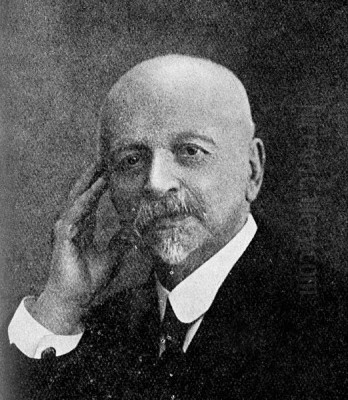
The story of French landscape painting in the late nineteenth and early twentieth centuries includes the contributions of two notable artists sharing the same name: Paul Lecomte. It is essential, however, to distinguish between Paul Lecomte the elder (1842-1920) and his son, Paul Emile Lecomte (1877-1950). Both men dedicated their careers to capturing the beauty of the French landscape and coastline, yet they developed distinct styles and achieved recognition in different ways within the evolving art world of their time. Understanding their individual paths and contributions requires careful attention to their respective biographies and artistic outputs.
Paul Lecomte (The Elder, 1842-1920): Foundations in Landscape
Paul Lecomte, the father, was born in Paris in 1842. He established himself as a painter specializing in landscapes and coastal scenes. His artistic focus was largely centered on the Île-de-France region, the area surrounding his native Paris. This region, with its gentle rivers, forests, and historical towns, provided ample inspiration for landscape artists of the period, including predecessors like Charles-François Daubigny and Jean-Baptiste-Camille Corot, whose works paved the way for later movements.
Lecomte's formal artistic training came under the tutelage of Emile-Charles Lambinet (1815-1877), himself a respected landscape painter known for his depictions of the Île-de-France and Normandy. This instruction likely grounded Lecomte in the traditions of French landscape painting that emphasized careful observation of nature, a quality evident in the works of the Barbizon School painters who preceded him.
Career and Recognition of Paul Lecomte Sr.
Beginning in 1868, Paul Lecomte became a regular exhibitor at the prestigious Paris Salon. The Salon was the official, state-sponsored exhibition venue and the primary path to recognition for most artists of the era. Consistent participation indicated a serious professional commitment and offered crucial visibility. His dedication and skill were acknowledged through several awards over his long career.
Notably, he received an Honorable Mention at the Exposition Universelle (World's Fair) held in Paris in 1889, a major international event showcasing cultural and technological achievements. Later, he was awarded a Silver Medal in 1900, likely also associated with the Exposition Universelle held that year in Paris. These accolades confirm his standing within the established art community of the time.
Style and Works of Paul Lecomte Sr.
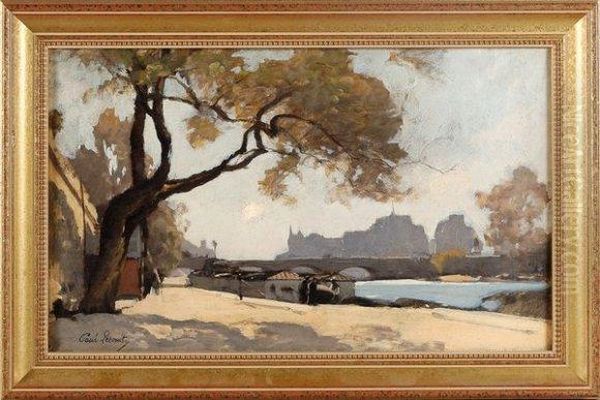
While the provided information contrasts his style with his son's more Impressionistic leanings, suggesting the elder Lecomte adhered more closely to academic or Barbizon-influenced traditions, specific details on his technique are limited in the source text. His focus remained on landscapes and coastal scenes.
One specific work attributed to him is Le Pont Neuf, dated 1877. This painting was exhibited in the same year and subsequently entered the collection of the Mulhouse Museum. The Pont Neuf, one of Paris's oldest bridges, was a popular subject for artists, including Impressionists like Camille Pissarro and Pierre-Auguste Renoir around the same period, though Lecomte's treatment may have differed in style. Other general titles mentioned, such as A Watermill and Market, likely represent typical themes within his oeuvre, reflecting the rural and daily life aspects often found in landscape traditions.
Paul Emile Lecomte (The Son, 1877-1950): Blending Tradition and Impressionism
Paul Emile Lecomte, born in Paris on October 29, 1877, followed directly in his father's artistic footsteps but forged his own distinct path. Growing up in an artistic household, he undoubtedly received early encouragement and foundational training from his father, Paul Lecomte Sr., particularly in the art of depicting nature. His life spanned a period of significant artistic change, witnessing the consolidation of Impressionism and the rise of Post-Impressionism and Modernism.
To further his education, Paul Emile enrolled at the renowned Ecole des Beaux-Arts in Paris, the bastion of academic art training in France. There, he studied under Fernand Cormon (1845-1924), a prominent painter known for his historical scenes and portraits, but who also taught landscape painting. Cormon's studio was famous and attracted many students who would later become significant figures, offering a rigorous academic grounding.
The Artistic Style of Paul Emile Lecomte
Paul Emile Lecomte developed a style that skillfully blended the formal structures learned through his academic training with the newer, vibrant ideas emerging from Impressionism. His work is often characterized as Impressionistic, particularly in its focus on light, color, and capturing fleeting moments, yet it retains a sense of solidity and composition derived from his Beaux-Arts education.
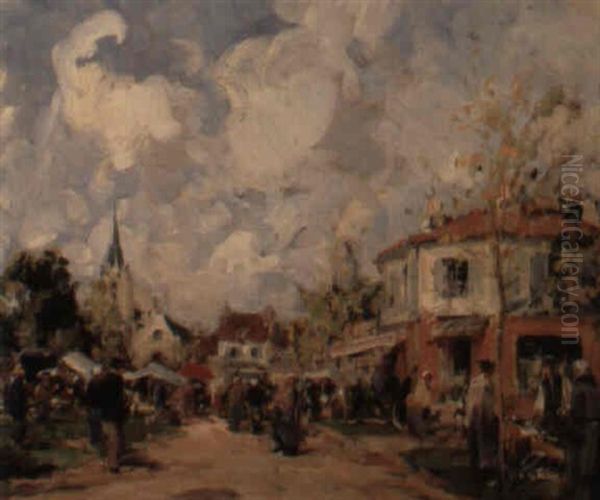
He employed thick applications of paint (impasto) and fluid brushstrokes to convey the textures and dynamism of the natural world. His primary subjects included the landscapes, bustling markets, and picturesque ports of France. He seemed particularly drawn to the regions of Brittany and Normandy, including the famous cliffs of Étretat, areas also beloved by Impressionist masters like Claude Monet. His paintings often evoke a sense of tranquility and harmony, capturing the serene beauty of the French countryside and coastline with delicate brushwork and a soft, appealing color palette.
Exhibitions and Acclaim for Paul Emile Lecomte
Active during the early twentieth century, Paul Emile Lecomte achieved considerable success within the established art system. Starting in 1902, he regularly exhibited his works at the Salon des Artistes Français, the successor organization to the traditional Paris Salon. His talent was recognized with significant awards from this institution.
He received a Silver Medal in 1922 and, notably, a Gold Medal in 1920. These prestigious awards underscore the high regard in which his work was held by the Salon juries and the broader art public frequenting these official exhibitions. His success demonstrates an ability to appeal to prevailing tastes while incorporating modern, Impressionistic sensibilities.
Paul Emile Lecomte and the Impressionist Movement
While clearly influenced by Impressionism, Paul Emile Lecomte's career trajectory differed from that of the movement's pioneers. The provided sources indicate that his style, though employing Impressionist techniques like broken brushwork and attention to light, maintained a degree of academic structure. His approach found a balance between the revolutionary freedom of artists like Monet and Renoir and the formal rigor of his training.
Crucially, there is no evidence presented to suggest that Paul Emile Lecomte actively participated in the independent exhibitions organized by the core Impressionist group in their earlier, more radical phase. Nor is there documented evidence of personal correspondence or close collaboration with leading Impressionist or Post-Impressionist figures such as Monet, Renoir, or Paul Cézanne. His primary venue for exhibition and recognition remained the official Salon system. His influences stemmed more directly from his father and his teacher, Fernand Cormon, rather than direct involvement with the Impressionist circle itself, which included artists like Edgar Degas, Alfred Sisley, and Berthe Morisot.
Representative Works of Paul Emile Lecomte
Several titles represent the characteristic subjects and style of Paul Emile Lecomte. Coin de Marche a Melun (Market Corner in Melun) captures a lively market scene, a recurring theme. Le moulin de Grainville (The Mill of Grainville) likely depicts a picturesque rural landscape centered around a watermill.
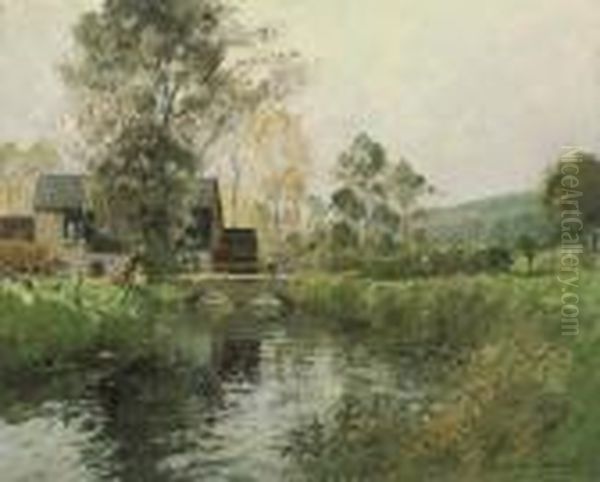
Other mentioned works further illustrate his focus on coastal and landscape views: La Grève du Mont-Saint-Michel vue d'Avranches (The Shore of Mont-Saint-Michel seen from Avranches) and Coin du port à La Rochelle (Corner of the Port at La Rochelle). These titles point to his travels and his interest in capturing specific, identifiable locations within France, rendered with his characteristic blend of Impressionistic light and academic composition. A watercolor titled The Flower Garden also indicates his work in that medium.
Market Presence and Collections (Paul Emile Lecomte)
Paul Emile Lecomte's paintings continue to be present in the art market. Auction records confirm the ongoing sale of his works. For instance, Coin de Marche a Melun, an oil painting measuring 26 x 32 inches, has appeared at auction. Le moulin de Grainville has also been offered for sale. More recently, in May 2024, a forest landscape by him sold at Bonhams Skinner for $537.60. His watercolor The Flower Garden reportedly fetched €1,800 at a Fall 2024 auction.
His works have been handled by various galleries, including Antiquités Lecomte and Galerie Paffrath. While his paintings are held in private collections and by unspecified art institutions, the provided information does not confirm the presence of his works in the permanent collections of major public museums. This suggests his market may be more concentrated within the gallery and private collector sphere.
Art Historical Perspective and Evaluation
Both Paul Lecomte Sr. and Paul Emile Lecomte contributed to the rich tradition of French landscape painting. The father established the family's artistic presence through consistent Salon participation and official recognition. The son built upon this foundation, adapting to the changing artistic climate by integrating Impressionist techniques into a more structured framework, achieving significant Salon success in his own right.
Paul Emile Lecomte is generally evaluated as a skilled painter adept at capturing the atmosphere and light of the French landscape and coastal regions. His blend of styles made his work accessible and popular within the Salon context of the early 20th century. He successfully navigated a path that acknowledged modern trends without fully abandoning traditional training, a position shared by other artists of his generation who sought recognition through established channels rather than avant-garde rebellion.
Points of Discussion and Controversy
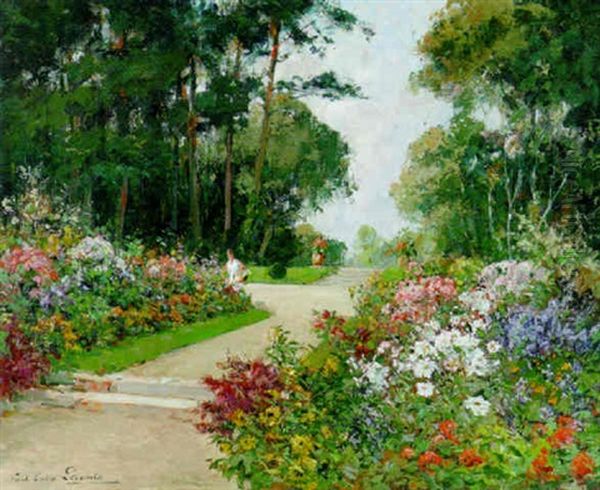
While respected, Paul Emile Lecomte's stylistic position has invited some discussion. For critics favoring more radical modernist developments, his work might appear somewhat conservative, retaining academic elements that the core Impressionists, like Pissarro or Sisley, had largely abandoned. His focus on well-composed, pleasing scenes might be seen as less challenging than the more experimental works of Post-Impressionists like Cézanne or contemporaries exploring Fauvism or Cubism, such as Henri Matisse or Pablo Picasso (though Picasso's early work also included more traditional phases).
One source snippet also introduced a confusing and likely inaccurate point of controversy, suggesting a link between Paul Emile Lecomte and the Surrealist movement. This claim starkly contrasts with all other descriptions of his work as being rooted in Impressionism and academic landscape traditions. Surrealism, which flourished later and focused on the subconscious and dream imagery (think Salvador Dalí or René Magritte), is stylistically and philosophically distant from Lecomte's known output. This mention likely stems from a misunderstanding or erroneous source and does not align with the established view of his artistic identity. It serves primarily as an example of potential misinformation in art historical records.
Conclusion: A Legacy of French Landscape
The Lecomtes, father and son, represent a continuum in French landscape painting across a period of profound artistic transformation. Paul Lecomte Sr. worked within the established traditions of the mid-to-late nineteenth century, achieving recognition through the Salon system. Paul Emile Lecomte inherited this legacy but adapted his style to incorporate the light and color of Impressionism, creating appealing works that earned him Gold and Silver medals at the Salon des Artistes Français in the early twentieth century.
While perhaps not central figures in the revolutionary narratives of Impressionism or Modernism, their dedication to depicting the landscapes, villages, and coastlines of France produced a significant body of work. Paul Emile Lecomte, in particular, crafted a successful career by blending academic skill with Impressionist sensibility, leaving behind paintings appreciated for their tranquil beauty and skillful execution. Distinguishing between the father and son allows for a clearer appreciation of their individual contributions to the enduring genre of French landscape art, alongside contemporaries ranging from the Impressionist masters like Monet and Degas to academic figures like his teacher Cormon, and earlier influences like Corot and Daubigny, or even slightly later figures like Gustave Caillebotte who also bridged styles.